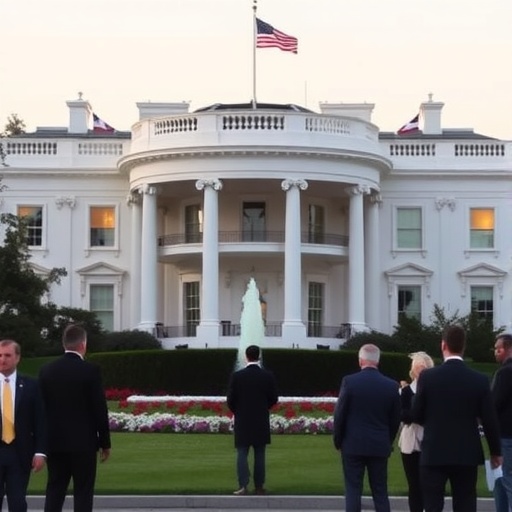White House East Wing Demolition Kicks Off for Trump‘s $250 Million Grand Ballroom Expansion
In a move that’s shaking up Washington D.C. and beyond, demolition crews have begun dismantling parts of the White House’s historic East Wing to pave the way for President Donald Trump‘s ambitious $250 million ballroom project. This marks the most significant structural alteration to the Executive Mansion since the iconic Truman Balcony was added in 1948, drawing cheers from supporters and sharp criticism from historians and transparency advocates alike.
- Demolition Crews Target East Wing for Trump’s Lavish Ballroom Vision
- Private Donors Pour Millions into White House Ballroom Without Taxpayer Burden
- Historians and Lawmakers Clash Over East Wing’s Role in White House Legacy
- Trump’s Ballroom Blueprints: From Design Inspirations to Global Diplomacy Boost
- Future Horizons: How Trump’s White House Ballroom Could Redefine Executive Entertaining
The project, entirely funded by private donors, aims to create what Trump has called “the most magnificent ballroom in the world,” capable of hosting up to 1,000 guests for state dinners, galas, and international summits. As jackhammers echo through the grounds this week, the initiative underscores Trump’s vision for a revitalized White House that blends grandeur with modern functionality. However, questions swirl around the funding sources, the project’s necessity, and its impact on one of America’s most treasured landmarks.
Demolition Crews Target East Wing for Trump’s Lavish Ballroom Vision
The demolition phase officially commenced on Monday morning, with specialized teams from the U.S. Army Corps of Engineers and private contractors cordoning off sections of the East Wing. This 19th-century structure, originally built in 1902 and home to offices for the First Lady and administrative staff, will see partial teardown to accommodate the new ballroom’s footprint. Engineers estimate that the core demolition work will take three to four months, followed by a 24-month construction timeline.
“We’re approaching this with the utmost respect for history,” said Project Director Elena Vasquez in a statement released by the White House. “The East Wing’s facade will remain intact where possible, but internal expansions are necessary to create a space that reflects America’s leadership on the global stage.”
Historical records indicate that the East Wing has undergone renovations before, including expansions during the Roosevelt and Kennedy administrations. But this project dwarfs those in scale. The new ballroom, spanning over 15,000 square feet, will feature crystal chandeliers imported from Europe, state-of-the-art acoustics, and climate-controlled environments for year-round events. Trump’s personal touch is evident in preliminary designs, which include gold-leaf accents and a central dance floor inspired by European palaces.
Security measures have been ramped up around the perimeter, with the Secret Service deploying additional barriers and surveillance to protect the ongoing work. Local D.C. residents report increased traffic and noise, but White House officials promise minimal disruption to daily operations. The East Wing’s staff has been temporarily relocated to nearby federal buildings, ensuring continuity in administrative functions.
Environmental assessments conducted prior to the start confirm that no asbestos or lead hazards were present in the targeted areas, a relief for workers and the public. Still, the visual transformation is stark: scaffolding now envelops the eastern facade, and debris removal trucks ferry away chunks of marble and plaster daily.
Private Donors Pour Millions into White House Ballroom Without Taxpayer Burden
Funding for the $250 million ballroom comes exclusively from private donors, a strategic move by the Trump administration to sidestep congressional appropriations and public scrutiny. High-profile contributors include real estate moguls, tech billionaires, and longtime Republican supporters, though exact names remain undisclosed pending ethics reviews.
“This is a public-private partnership at its finest,” Trump tweeted from his Mar-a-Lago estate on Tuesday. “No money from your pockets— just generous Americans making the White House greater than ever! #MAGA” The president’s enthusiasm has galvanized his base, with online petitions supporting the project garnering over 500,000 signatures in the first 48 hours.
According to filings with the Federal Election Commission, the White House Historical Association and a newly formed nonprofit, the Presidential Legacy Fund, are spearheading donations. Initial pledges total $180 million, with the remainder expected from corporate sponsors during groundbreaking ceremonies. Notable incentives for donors include naming rights for sub-rooms and invitations to the inaugural gala, set for late 2026.
Experts in nonprofit governance praise the model’s efficiency but warn of potential conflicts. “Private funding accelerates projects like this, but transparency is key to maintaining public trust,” said Dr. Miriam Hale, a political ethics professor at Georgetown University. “We’ve seen similar initiatives in past administrations, but the scale here demands rigorous disclosure.”
The ballroom’s budget breakdown reveals hefty allocations: $100 million for construction and materials, $50 million for interior design and furnishings, $40 million for security integrations, and $60 million for ancillary features like a rooftop terrace and underground parking for dignitaries. This private approach echoes Trump’s business background, where he often leveraged personal networks for large-scale developments.
- Key Funding Milestones: $50 million raised in Q1 2023 from initial donors.
- $100 million committed by summer 2023 following Trump’s public announcement.
- Remaining funds targeted for completion by end of 2024.
Critics, however, point to the opacity as a red flag. The Campaign Legal Center has filed a Freedom of Information Act request seeking donor lists, arguing that undue influence could sway policy decisions.
Historians and Lawmakers Clash Over East Wing’s Role in White House Legacy
The decision to alter the East Wing has ignited a firestorm among preservationists, who view it as an assault on the White House’s architectural integrity. Built during Theodore Roosevelt’s presidency to house growing administrative needs, the East Wing symbolizes the evolution of the executive branch. Its demolition for a ballroom—seen by some as a vanity project—has prompted lawsuits and congressional hearings.
“This isn’t just about bricks and mortar; it’s about erasing history,” lamented Sarah Jenkins, executive director of the National Trust for Historic Preservation. In a op-ed for The Washington Post, Jenkins highlighted how previous changes, like the Truman Balcony’s 1948 addition, were necessitated by structural decay rather than aesthetic upgrades. “The Truman renovation saved the White House from collapse. Trump’s ballroom? It’s luxury at the expense of legacy.”
On Capitol Hill, bipartisan concerns are mounting. House Oversight Committee Chair Rep. Jamie Raskin (D-MD) has scheduled briefings to probe the project’s compliance with the National Historic Preservation Act. “While private funds are welcome, the White House belongs to the people, not personal whims,” Raskin stated during a press conference. Senate Minority Leader Chuck Schumer echoed these sentiments, calling for a moratorium until an independent review is completed.
Supporters counter that the ballroom addresses practical shortcomings. The current state dining facilities, they argue, are outdated for hosting mega-events like G20 summits or celebrity-laden fundraisers. White House Chief of Staff Susie Wiles defended the necessity in a Fox News interview: “President Trump wants a venue that matches America’s prestige. The East Wing expansion will host diplomacy, not just dances.”
Polls reflect the divide: A recent Quinnipiac survey shows 52% of Republicans approve of the project, compared to 28% of Democrats. Among independents, approval hovers at 41%, with cost and historical impact as top concerns.
The controversy has also spotlighted the White House’s maintenance backlog. A 2022 Government Accountability Office report estimated $500 million in deferred repairs across the residence and wings, raising questions about priorities. Trump’s team insists the ballroom will incorporate upgrades to aging infrastructure, such as reinforced foundations and energy-efficient systems.
Trump’s Ballroom Blueprints: From Design Inspirations to Global Diplomacy Boost
Diving into the details, the ballroom’s design draws from Trump’s affinity for opulent architecture, blending neoclassical elements with contemporary flair. Architects from Skidmore, Owings & Merrill—known for projects like the Burj Khalifa—have unveiled renderings showing a soaring 40-foot ceiling, walls adorned with American artwork, and flexible partitioning for multi-purpose use.
“Imagine hosting world leaders under a dome reminiscent of the Capitol, with views of the South Lawn,” Trump described during a campaign rally in Florida. The space will integrate advanced technology, including holographic projection for virtual attendees and AI-driven lighting that adjusts to event themes.
Diplomatically, the ballroom is pitched as a game-changer. Current White House venues max out at 500 guests, limiting elaborate receptions. The new facility could accommodate full delegations, fostering closer ties with allies. Foreign policy experts like former Ambassador Nikki Haley have endorsed the idea: “In a post-pandemic world, physical spaces for diplomacy matter more than ever. This could put America back at the center of global gatherings.”
Economically, the project is expected to inject $300 million into the D.C. economy through construction jobs and tourism. Over 1,200 workers, including welders, electricians, and artists, will be employed, with priority given to veterans and local hires. Union leaders from the AFL-CIO have negotiated favorable terms, including prevailing wages and apprenticeship programs.
Yet, sustainability remains a flashpoint. While the design incorporates LEED-certified materials and solar panels on adjacent structures, environmental groups like the Sierra Club criticize the carbon footprint of imported luxuries. “A $250 million ballroom in 2023? We need green initiatives, not gilded excess,” said Sierra Club executive director Michael Brune.
Inside sources reveal iterative changes to the blueprints, with Trump personally vetoing minimalist proposals in favor of bolder aesthetics. The result: a venue that could rival Versailles in splendor, complete with a private elevator for the presidential family and secure bunkers beneath for emergencies.
Future Horizons: How Trump’s White House Ballroom Could Redefine Executive Entertaining
As demolition dust settles, the ballroom project signals a bold pivot for the White House’s role in American life. Completion by 2026 would coincide with the midterms, potentially serving as a backdrop for victory celebrations or policy unveilings. Long-term, it could host annual traditions like the Nobel Prize dinners or expanded holiday tours, drawing millions in visitors.
Legal hurdles notwithstanding, White House counsel anticipates approvals by year’s end, paving the way for full-scale construction. International reactions are mixed: European leaders express intrigue at the grandeur, while some Asian allies worry about perceived extravagance amid global inflation.
Ultimately, the project encapsulates Trump’s unapologetic style—transformative, controversial, and larger-than-life. Whether it elevates the presidency or divides the nation further, one thing is clear: the White House is entering a new era of spectacle. Stakeholders from Congress to conservationists will watch closely as the East Wing’s transformation unfolds, shaping the Executive Mansion for generations to come.
Stay tuned for updates as the demolition progresses and donor details emerge.









